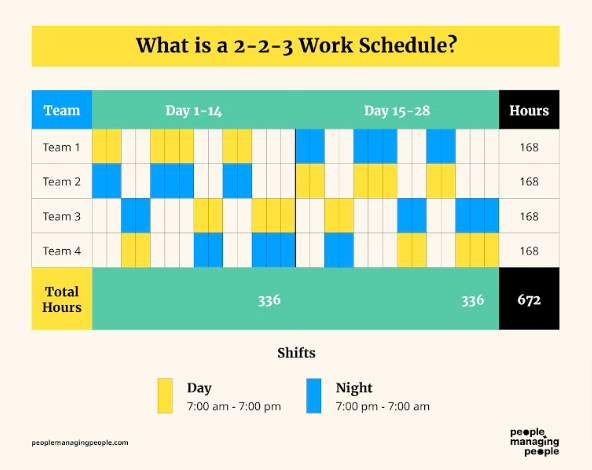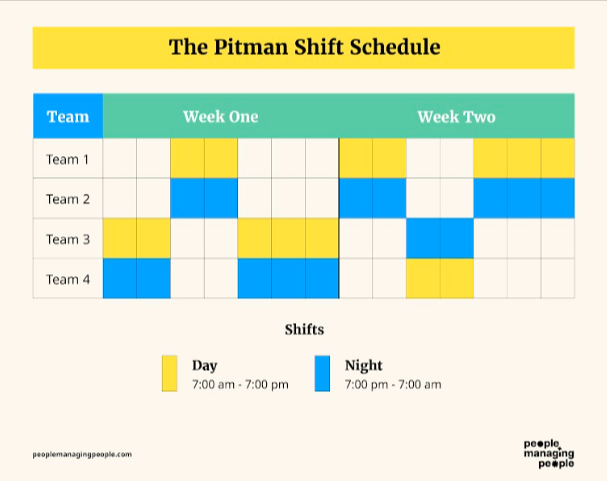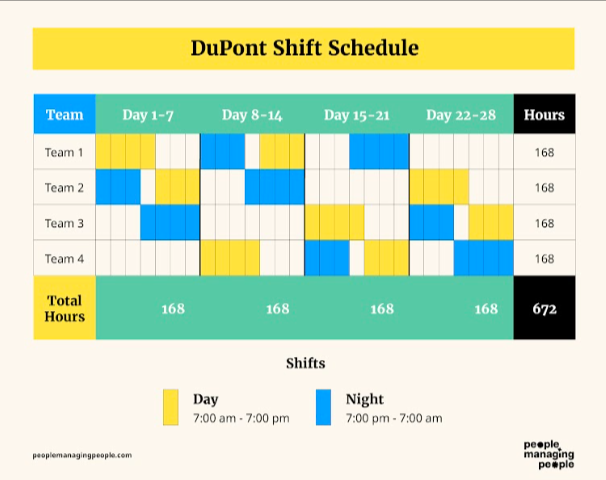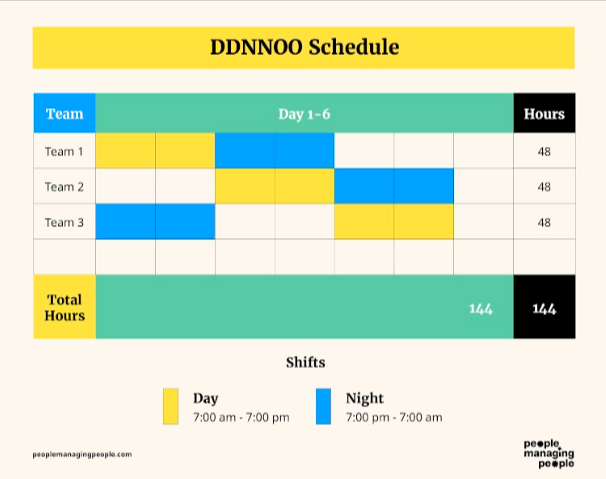Managing shift schedules in industries that require 24/7 coverage is no easy task. Employers need a system that ensures continuous operations while balancing employee well-being. At the same time, workers want predictable schedules that allow for work-life balance without excessive fatigue. This is where the 2-2-3 schedule comes in.
This shift work system is designed for around-the-clock staffing, using a structured four-week cycle where employees alternate between two or three consecutive workdays followed by two or three days off.
Typically, these schedules involve early morning shifts, late-night shifts, or rotating shifts, making them common in industries such as healthcare, manufacturing, law enforcement, and emergency services. For example, many hospital nurses work on a 2-2-3 schedule to ensure seamless patient care without long stretches of consecutive shifts.
Beyond operational efficiency, this system benefits employees by providing more consecutive days off, allowing for better rest and personal time compared to traditional five-day workweeks.
In the following sections, we’ll break down how the 2-2-3 schedule works, its advantages and challenges, and whether it’s the right choice for your workforce.
What is a 2-2-3 Work Schedule?
A 2-2-3 work schedule, also known as the Panama schedule, is a rotating shift pattern that ensures continuous 24/7 coverage by alternating between two and three workdays with two and three days off in a repeating cycle. Employees typically work 12-hour shifts, and the full cycle repeats every four weeks.
This schedule is commonly used in industries requiring rotating shift schedules, such as healthcare, manufacturing, emergency services, and public safety. It provides a structured way to maintain operations without overworking employees, giving them every other weekend off and more consecutive rest days than traditional work schedules.
While the 2-2-3 schedule offers predictability and work-life balance benefits, adjusting to long 12-hour shifts—especially when alternating between day and night rotations—can be challenging for some workers. However, for many, the trade-off of longer shifts in exchange for frequent multi-day breaks is well worth it.

Which Industries Use a 2-2-3 Schedule?
The 2-2-3 schedule is widely used in industries that require continuous operations and around-the-clock staffing. Its structured rotation helps businesses maintain efficiency while reducing employee burnout.
Here are some of the industries that commonly use this shift pattern and why:
- Healthcare – Hospitals, urgent care centers, and emergency rooms require 24/7 coverage. The 2-2-3 schedule allows nurses, doctors, and medical staff to work long but manageable shifts while ensuring patient care remains uninterrupted.
- Manufacturing & Production – Factories and industrial plants often operate non-stop to maximize output and efficiency. This shift structure ensures consistent staffing without excessive overtime.
- Law Enforcement – Police officers and emergency responders need to be available at all hours. The rotating nature of the 2-2-3 schedule provides fair coverage while giving officers predictable rest days.
- Fire Departments & Emergency Services – Firefighters and paramedics follow similar shift patterns to law enforcement, ensuring rapid response times without exhausting personnel.
- Energy & Utilities – Power plants, water treatment facilities, and utility companies must operate continuously. This schedule helps manage shifts for engineers and technicians maintaining critical infrastructure.
- Aerospace & Aviation – Air traffic controllers, airport security, and airline maintenance crews often work on a 2-2-3 schedule to keep flights running safely and efficiently.
- Security Services – Private security firms use this system to provide round-the-clock protection while preventing employee fatigue.
- Retail & Hospitality – Large hotels, casinos, and 24-hour retail stores may use this schedule to maintain full-time staffing without overworking employees.
By implementing the 2-2-3 schedule, these industries ensure consistent service, reduce fatigue-related errors, and provide employees with predictable time off.
Variations on the 2-2-3 Work Schedule
While the 2-2-3 schedule is a popular rotating shift pattern, several variations exist to accommodate different business and employee needs. Some organizations tweak the structure to balance workload, provide more flexibility, or address industry-specific demands.
Below are some of the most common alternatives:
Pitman Shift Schedule

The Pitman shift schedule is a variation of the 2-2-3 schedule that allows employees to have every other weekend off while working a combination of day and night shifts.
It follows a four-week repeating cycle, where employees work two or three days at a time, alternating between day shifts and night shifts every two weeks.
| Advantages | Disadvantages |
| ✅ Provides predictable rest days, helping with work-life balance | ❌ 12-hour shifts can still be physically and mentally demanding |
| ✅ Ensures fair coverage, with employees rotating evenly through different shifts | ❌ Alternating between day and night shifts may cause disruption to sleep schedules |
| ✅ Reduces fatigue compared to traditional five-day workweeks |
DuPont Shift Schedule

The DuPont schedule is a rotating 12-hour shift system that operates on a four-week cycle, alternating between day shifts, night shifts, and rest days.
The structure includes:
- Four consecutive night shifts, followed by three days off
- Three consecutive day shifts, followed by one day off
- Three consecutive night shifts, followed by three days off
- Four consecutive day shifts, followed by seven days off
| Advantages | Disadvantages |
| ✅ Employees get a full week off every month | ❌ The four consecutive shifts (especially nights) can be exhausting |
| ✅ Balances workload across different shifts | ❌ Requires employees to adjust between night and day shifts frequently |
| ✅ Useful for businesses that need continuous operations |
DDNNOO Schedule

The DDNNOO schedule is another rotating shift pattern designed for 24/7 coverage. Employees work two consecutive day shifts (D), two consecutive night shifts (N), followed by two days off (O). This cycle repeats every six days.
| Advantages | Disadvantages |
| ✅ Regular, predictable cycle makes scheduling simple | ❌ Frequent transitions between day and night shifts can disrupt circadian rhythms |
| ✅ Provides a balanced mix of work and rest days | ❌ Can be tough to adjust to, especially for new employees |
| ✅ Employees get two consecutive days off after night shifts, reducing fatigue |
Panama Plus Shift Schedule

The Panama Plus shift schedule is another variation of the standard 2-2-3 schedule, that incorporates 8-hour shifts in between 12-hour day and night shifts. This schedule, while complicated, is sometimes used to provide staff with a shorter day for administrative tasks or training purposes.
It follows a 40-week cycle for five work teams, which ensures that each team eventually works each possible sequence in the scheduling pattern.
Using this fixed scheduling pattern, each team would work the following shift sequences:
- 2 day shifts > 2 days off > 3 day shifts > 2 days off > 2 day shifts > 3 days off (repeated 4 times over 8 weeks)
- 8-hour weekday shifts for 2 weeks
- 2 night shifts > 2 days off > 3 night shifts > 2 days off > 2 night shifts > 3 days off (repeated 4 times over 8 weeks)
- 8-hour weekday shifts for 2 weeks
- 2 days off > 2 day shifts > 3 days off > 2 day shifts > 2 days off > 3 day shifts (repeated 4 times over 8 weeks)
- 8-hour weekday shifts for 2 weeks
- 2 days off > 2 night shifts > 3 days off > 2 night shifts > 2 days off > 3 night shifts (repeated 4 times over 8 weeks)
- 8-hour weekday shifts for 2 weeks
| Advantages | Disadvantages |
| ✅ Reduces overtime costs by incorporating 8-hour days periodically | ❌ The two-week periods of long shifts can be difficult for some employees |
| ✅ Includes dedicated time for meetings, administrative tasks, or training | ❌ Require more coordination and dedicated software to implement successfully |
| ✅ Offers regular consecutive days off which can improve work-life balance | ❌ Makes it challenging to manage time-off requests or unexpected sick days |
Benefits of Using a 2-2-3 Schedule
Implementing a 2-2-3 work schedule offers several advantages for both employers and employees, particularly in industries requiring continuous operations.
Here are several key benefits you can expect from implementing a 2-2-3 work schedule:
- Better Work-Life Balance: The 2-2-3 schedule provides employees with regular intervals of time off, including every other weekend, facilitating better personal planning and rest. This structure supports a healthier work-life balance, which can lead to increased job satisfaction and reduced turnover.
- Increased Productivity: By working longer shifts followed by consecutive days off, employees can maintain focus during work periods and return refreshed after their breaks. This cycle can enhance overall productivity and efficiency.
- Consistent 24/7 Coverage: For businesses that require 24-hour operations, the 2-2-3 schedule facilitates staffing without overburdening employees. This consistency is crucial in sectors like healthcare, manufacturing, and emergency services.
- Predictable Scheduling: Because the pattern repeats regularly, employees can anticipate their days of work and off days well in advance. This predictability aids in personal planning and reduces the stress associated with uncertain schedules.
- Reduced Burnout: Regularly scheduled days off, including three-day weekends every other week, provide employees with ample time to rest and recover. This structure helps in mitigating fatigue and burnout, common in demanding work environments.
By adopting the 2-2-3 schedule, organizations can achieve a balance between operational demands and employee well-being, leading to a more motivated and effective workforce.
How To Manage a 2-2-3 Shift Schedule
Successfully implementing a 2-2-3 shift schedule requires careful planning, clear communication, and the right tools to manage rotating shifts efficiently. While this schedule provides continuous coverage and predictable work patterns, managers and HR teams must navigate scheduling complexities, employee preferences, and shift-related fatigue.
To help you effectively manage a 2-2-3 schedule, here are key steps to consider:
- Structure your team properly to support the full rotation cycle.
- Use scheduling software to reduce manual work and prevent errors.
- Create clear guidelines for managers to support employees.
- Communicate policies transparently so employees understand your expectations.
Below, we’ll explore each of these factors in more detail.
Team Structure Requirements
A well-structured team is the foundation of a successful 2-2-3 schedule. Since this shift pattern requires rotating teams covering 12-hour shifts, managers must ensure that staffing is balanced to prevent gaps in coverage or excessive overtime.
- Divide employees into four teams to rotate through the 2-2-3 rotation cycle fully.
- Ensure each team alternates between day and night shifts to prevent burnout.
- Account for overtime, sick days, and vacations by having backup coverage available.
- Consider employee preferences where possible, allowing voluntary shift swaps to improve employee morale.
Common Challenge: Some employees may struggle with adjusting to 12-hour shifts, especially if they are new to rotating schedules.
Solution: Offer guidance on sleep schedules, meal breaks, and fatigue management to help them transition smoothly.
Simplify with Software
Manually tracking a 2-2-3 shift schedule can quickly become overwhelming, especially in large organizations. Employee shift scheduling software simplifies this process by automating shift assignments, tracking time-off requests, and ensuring balanced workloads.
With the right software, you can:
- Create and adjust schedules with minimal effort.
- Enable employees to swap shifts or request time off without disrupting coverage.
- Track attendance and overtime to prevent excessive labor costs.
- Improve compliance with labor laws by ensuring fair rest periods.
For an example of an affordable shift-scheduling system in action, check out our detailed review of QuickBooks Time for more details.
Develop Guidelines for Managers
Shifting to a 2-2-3 schedule can be a big adjustment, so managers will play a crucial role in helping employees transition smoothly and resolve concerns. To set them up for success:
- Provide training on how the shift structure works and how to support employees.
- Encourage open communication so workers feel comfortable voicing concerns.
- Monitor workload distribution to avoid excessive overtime or burnout.
- Address scheduling conflicts proactively, offering flexibility when possible.
Tip: Hold regular check-ins with employees after implementing the 2-2-3 schedule to gather feedback and make necessary adjustments.
Share Policies with Employees
Employees should fully understand how the 2-2-3 schedule impacts their work-life balance, pay structure, and expectations. Clear policies help prevent confusion and ensure compliance.
- Document shift policies and make them easily accessible.
- Explain how shift swaps and time-off requests work to avoid disruptions.
- Provide a point of contact (either HR or a manager) for questions and concerns.
- Regularly update employees on scheduling changes or company adjustments.
Best Practice: Post schedules in a central location (such as an employee portal or scheduling app) so workers always know when they’re on duty.
7 Shift Scheduling Tips to Improve Implementation
Implementing a 2-2-3 schedule successfully requires careful planning and consideration of employee well-being. Here are seven essential tips to streamline the transition and optimize shift work for your team.
1. Keep Communication Lines Open
To launch your new scheduling system, clearly explain how the 2-2-3 schedule works to employees and managers and address any concerns early. Regular check-ins with both managers and staff to ensure that the transition goes smoothly and that adjustments can be made if necessary.
You may also want to consider posting answers to frequently asked questions on your company intranet, in your employee handbook, or in communal work spaces, such as your lunch room.
2. Pick Your Starting Time Carefully
The start time of shifts can impact employee alertness and work-life balance. Avoid early-morning starts if possible, and consider employee commutes, natural sleep cycles, and peak business hours when setting shift times.
You should also consider annual fluctuations in your scheduling needs too. It might add unnecessary stress to implement a new scheduling structure during an already busy time. Instead, try to launch your new 2-2-3 schedule during a calmer business period.
3. Balance Your Teams Before Implementation
Distribute employees evenly across shift-teams, ensuring a fair mix of experience levels, skill sets, and personal circumstances (e.g., parents, caregivers). A diverse team structure helps maintain productivity and morale across all shifts.
For example, you’ll want to avoid creating schedules with all your employees from one category (such as people with kids, or those who celebrate specific holidays) in one group, which may lead to staffing shortages due to caregiver responsibilities or other needs.
4. Use Mobile-Friendly Scheduling Software
It’s important to choose scheduling software that’s mobile-friendly so your workers can access schedules, request time off, and swap shifts via mobile devices. This improves engagement, flexibility, and overall workforce efficiency.
5. Offer Restful Break Spaces
Providing quiet, comfortable break areas allows employees to recharge and take power naps during long shifts, if needed. A well-designed rest area with comfortable seating, dim lighting, and minimal noise can help reduce fatigue and improve focus.
6. Adjust Your Workspace Lighting
Proper lighting can reduce eye strain, improve alertness, and support circadian rhythms for employees working rotating shifts. Use warmer lights at night and cooler, brighter lights during the day to help employees stay alert without disrupting their sleep patterns.
7. Be Mindful of Caffeine and Sugar Consumption
Encourage employees to limit caffeine and sugar intake toward the end of their shifts to prevent sleep disturbances and energy crashes. Providing healthier snack alternatives and hydration stations can promote sustained energy levels throughout long shifts.
Frequently Asked Questions
Below are answers to common questions about shift work and the 2-2-3 schedule.
What is shift work?
Shift work is any work schedule outside the standard 9-to-5 hours, often used in industries requiring 24/7 operations. It includes rotating shifts, night shifts, and fixed schedules to ensure continuous business coverage.
What are the most common shifts?
The most common shifts include day shifts (8 AM – 4 PM), evening shifts (4 PM – 12 AM), and night shifts (12 AM – 8 AM).
Rotating shifts, 12-hour shifts (e.g., 6 AM – 6 PM, 6 PM – 6 AM), and split shifts are also widely used in industries requiring continuous operations.
What is a fixed vs rotating schedule?
A fixed schedule assigns employees to the same shift consistently (e.g., always working 8 AM – 4 PM).
A rotating schedule shifts employees between different time slots, such as switching from day shifts to night shifts on a set cycle to ensure equal distribution of work hours.
What is a 2-2 shift?
A 2-2 shift is a rotating schedule where employees work two consecutive days, then have two days off, typically repeating in a continuous cycle. It is often used in industries requiring 24/7 coverage, sometimes alternating between day and night shifts.
What is a 3-2-2- workweek?
A 3-2-2 workweek is a rotating shift pattern where employees work three days, have two days off, work two more days, then repeat. This schedule helps balance workload and time off, often used in 24/7 industries to ensure continuous operations while providing employees with regular breaks.
What is a 2-2-1 work schedule?
A 2-2-1 work schedule is a rotating shift pattern where employees work two consecutive days, two consecutive nights, followed by one day off before the cycle repeats. It’s commonly used in public safety, healthcare, and manufacturing to ensure continuous 24/7 coverage while balancing rest periods.
What types of software can help manage employee schedules?
Workforce management software helps businesses automate shift scheduling, track attendance, and manage time-off requests to streamline operations. These tools often include employee scheduling, compliance tracking, and real-time workforce analytics.
To learn more, check out this guide to workforce management software.
Should you formalize an employee scheduling policy?
Yes, a formalized employee scheduling policy ensures fairness, consistency, and transparency in shift assignments. It helps prevent miscommunication, last-minute changes, and scheduling conflicts while setting clear expectations for shift swaps, overtime, and time-off requests.
A documented policy also supports compliance with labor laws and improves employee satisfaction.
For more advice on HR policies, read this guide to HR policies and best practices next.
How can a 2-2-3 schedule impact employee relations?
A rotating shift schedule like 2-2-3 can affect team dynamics, communication, and workplace relationships by altering when employees interact. Strong employee relations strategies—such as clear communication, fair shift assignments, and open feedback channels—can help maintain a positive workplace culture.
For more ways to strengthen workplace relationships, check out this guide on improving employee relations.
What challenges do rotating shift schedules pose for company culture?
Workplaces with rotating schedules often struggle with team cohesion, communication gaps, and employee burnout, all of which can weaken company culture.
Creating engagement initiatives, prioritizing work-life balance, and fostering a sense of community can help counter these challenges.
For more advice, hop over to our step-by-step guide full of tips to strengthen your company culture.
Improve Your Employee’s Experience With a 2-2-3 Schedule
Implementing a 2-2-3 schedule can be a valuable solution for businesses that operate 24/7, but its success depends on careful planning, clear communication, and the right tools. When implemented thoughtfully, it helps balance operational efficiency with employee well-being, providing predictability, work-life balance, and reduced burnout.
If you're considering this schedule, start by evaluating team structure, investing in scheduling software, and ensuring employees understand expectations. Open communication, flexibility, and a focus on employee well-being will make all the difference.
Using workforce analytics software can also help you track trends such as productivity or other relevant metrics before and after you implement your new schedule, to help you further analyze the impact.
Join For More HR Insights
Want more insights on optimizing workforce management? Join us at People Managing People for expert strategies and best practices!
By subscribing to our newsletter, you'll receive insights and offerings tailored to leaders and HR professionals straight to your inbox.







